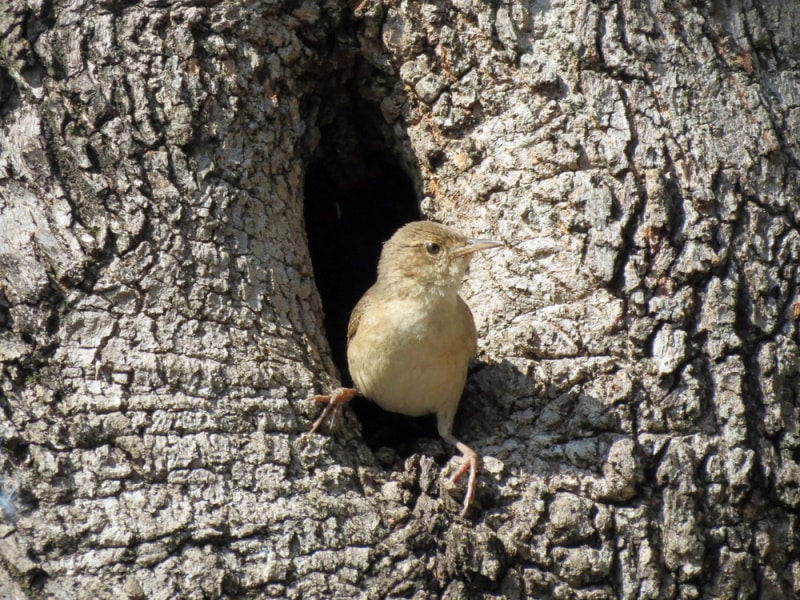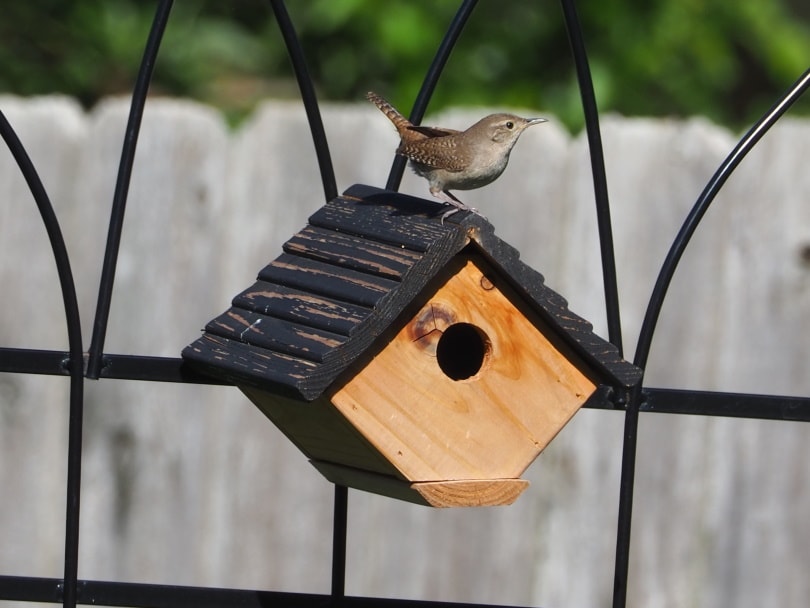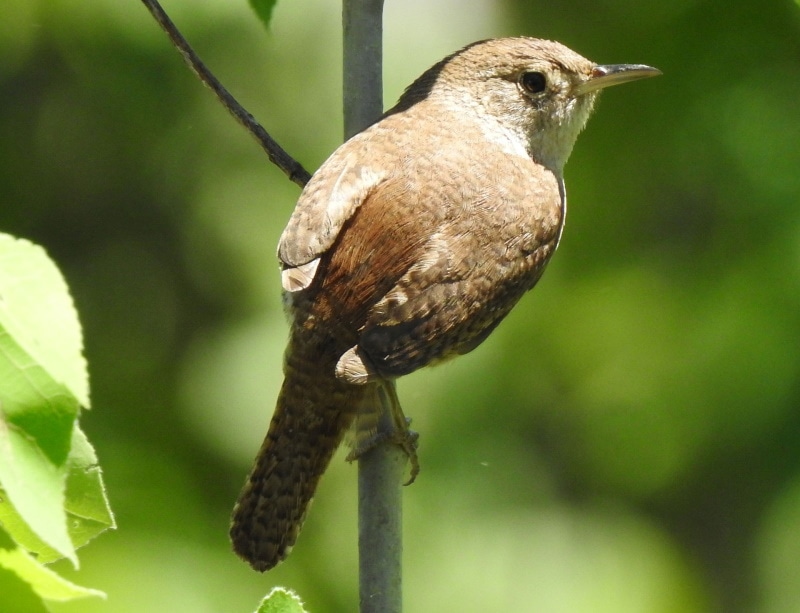Where Do House Wrens Nest? What Are the House Wren’s Nesting Habits?
Last Updated on

If you’re keen on bird watching, you’ve probably spotted the House Wren once or twice, as it’s the most abundant of the Wren species. As a result, attracting them to your backyard is as easy as it gets.
Since these birds are tolerant of humans, it’s not hard to observe their habitat or nesting habits. So, if you want to learn more about where and when these birds nest, you’re in luck. Here’s everything you need to know about the House Wren and its nesting habits. In short, House Wrens build their round cup-shaped nests between four and 30 feet above the ground. The nests are distinctive because they have stick-supported bases. Keep reading for more!

What Is a House Wren?
A House Wren is a brown bird from the Wren species, offering a plain and unassuming appearance. Their lower bodies are a simple tan shade, with white-edged feathers. Other birds in the Wren species have an eye stripe setting them apart, but this feature is missing in the House Wren.
Another unique fact about this bird is the little difference between the female and the male, unlike other birds, which are easily distinguishable. Furthermore, the House Wren is known for its melodious song, as it has one of the largest ranges of any songbird in the New World.
During the breeding season, the bird migrates from Canada through Central America to the southernmost point of South America.

Where Do House Wrens Nest?
House Wrens build their nests four to 30 feet above the ground, mounting them or leaving them hanging. Their nest resembles a round cup built by the male House Wren, which works on the base of sticks supporting the nest. Cavity-nesting birds are the only species that opt for these stick bases, making it easier for you to identify a House Wren’s nest.
The nest shape may be hard to assess, but it’s clear that they nest in enclosures of varying shapes and sizes. These birds nest in natural crevices, old woodpecker holes, or nest boxes placed by humans, including shoes, tins, etc.
If you’re planning to place a House Wren house, look for sheltered areas with sufficient shade and protection of trees. It would also help to hang the house 5–10 feet above the ground with the entry hole facing away from the wind to protect the birds.
When Do House Wrens Build Their Nest?
After the breeding season, these migratory songbirds move to warmer areas. Then, they return to their breeding grounds to work on their nests as the breeding season begins. House Wrens build their nests from April to July, but some may start as early as March if they’ve been residing in Southern areas year-round.
In the North, these birds prefer not to build their nests until summer. Where they live and weather patterns greatly influence when the House Wren builds its nest. During this time, they look for the appropriate hollows in buildings, barns, or houses to build their nest in.
When disappointed, they may also settle for cavities in trees, old woodpecker holes, or abandoned nests of other birds. In simpler words, they don’t hollow out places, as you might catch a woodpecker, but they rely on cavities provided by nature or humans.
The male and female House Wren work on the nest together, but the former focuses mostly on the base. The two take turns gathering material while one stays at the nesting site 5–30 feet above the ground.
Overall, it takes a little over a week to build the first nest before they continue building a few additional ones, which can be as quick as four days.

How Do House Wrens Build Their Nests?
The male House Wren first migrates to the breeding grounds in Canada or North America to find a suitable spot for nesting and marking their territory. Next, they look for pre-made cavities and begin building various bases of sticks for multiple nests.
Then, the female House Wren migrates to the breeding ground and assesses the male’s preparation. If she approves of his nest bases and sites, the female begins building the rest of the nest, indicating that the two are a pair now.
However, this pairing may only last as long as the breeding season, as these birds are famous for separations and mate switching. Unfortunately, most female House Wrens leave their partners to move on with a new mate in a different territory and nesting site. Then, the lone male House Wren stays in his nesting site and mates with other females within the territory.
What Are the House Wren’s Nesting Habits?
As mentioned, House Wrens prefer to build their nests in cavities but don’t create their cavities. Instead, they opt for natural cavities or old woodpecker holes. When these options disappoint, House Wrens get creative at finding the right cavity for their nest.
They make homes in flowerpots, hanging boots, crane parts, sheds, cloth pockets, and many other unique spots. Placing a nesting house for them is a generous and foolproof act since these birds are tolerant of humans and accepting of nesting houses. Studies have found that they even prefer nesting houses above natural cavities.

How Do House Wrens Defend Their Nests?
House Wrens may only weigh 11 grams, but they fiercely protect their nesting sites and territories. In addition, they work their hardest to attain the nesting site in the first place, fighting any obstacle in their way.
These birds harass much larger birds for their territories, even pecking at them to give up their nesting sites. Often, the House Wren may drag another bird’s eggs or babies out of their nest and inherit their home instead. When necessary, these birds kill much larger birds.
House Wrens are so competitive in nesting that they’ve become the main reason behind nesting failures for chickadees, swallows, warblers, and bluebirds. However, this isn’t the only way these birds protect their nests.
As the season gets warmer, their nests become vulnerable to mite infestations or other parasites. These parasites feed on the House Wren nestlings, which is why the birds come up with unique solutions to fight them.
While building their nests, they often include spider egg sacs in the material. Once the eggs hatch, the spiders devour the parasites in the House Wren’s nest.
Do House Wrens Reuse Their Nests?
House Wrens prefer to stick to one nesting site where they return every breeding season. If their nest hasn’t been damaged or removed, these birds may reuse the same nests. The male makes the necessary repairs to make the nest as good as new.
Sometimes, the female may choose a new nesting site, where the pair works to build a new nest. Those utilizing nesting houses prefer to reuse the same nest for their second brood.
Once the nest is fully utilized or soiled by the previous brood, the male House Wren collects the nesting material and builds a new nest elsewhere. They ensure to replace the nest material sufficiently to prevent parasites from damaging the next brood.

Do House Wrens Abandon Their Nests?
House Wrens do not abandon their young but often abandon their nests if it’s soiled or heavily utilized. They often find their nests destroyed after migrating back to their breeding grounds, where they begin searching for a new, safer nesting site for their next brood.
In addition, they may abandon their nests between breeds, finding better breeding sites for their second batch.
Although they don’t abandon their young, they may refuse to feed them as it helps them leave the nest much sooner in search of food. However, this test doesn’t last long, as their young are ready to enter the world within just a few weeks.
Each year, the House Wren has two to three broods, each consisting of five to eight eggs. The incubation period lasts nearly two weeks before they hatch. Then, the House Wren babies stay in their nest for up to 18 days before learning to fly.
Once they leave, the pair begins preparing for their next brood.

Conclusion
House Wrens are unassuming in appearance, but their nesting habits are smart and tactful. Brave enough to fight much larger birds for their nests, these birds enforce unique security measures to protect their young and nesting sites.
Their brown color makes them hard to detect in nature, but their nesting habits inevitably make the House Wren stand out. They are easy to spot, so welcome them to your home and feed them well.
Featured Image Credit: Daniel Hincapie, Shutterstock
About the Author Jeff Weishaupt
Jeff is a tech professional by day, writer, and amateur photographer by night. He's had the privilege of leading software teams for startups to the Fortune 100 over the past two decades. He currently works in the data privacy space. Jeff's amateur photography interests started in 2008 when he got his first DSLR camera, the Canon Rebel. Since then, he's taken tens of thousands of photos. His favorite handheld camera these days is his Google Pixel 6 XL. He loves taking photos of nature and his kids. In 2016, he bought his first drone, the Mavic Pro. Taking photos from the air is an amazing perspective, and he loves to take his drone while traveling.
Related Articles:
10 Types of Hummingbirds in Arkansas (With Pictures)
8 Types of Hummingbirds in Nebraska (With Pictures)
5 Types of Hummingbirds in Idaho (With Pictures)
3 Types of Hummingbirds in Mississippi (With Pictures)
8 Types of Hummingbirds in Kansas (With Pictures)
5 Types of Hummingbirds in West Virginia (With Pictures)
5 Types of Hummingbirds in Ohio (With Pictures)
Where Do Nuthatches Nest? Nuthatch Nesting Habits Explained
